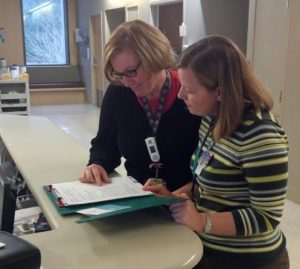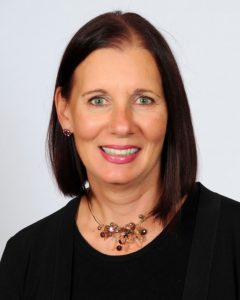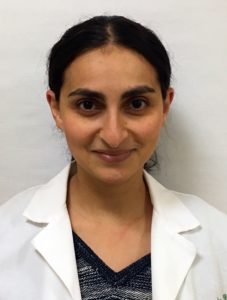
Clinical pharmacist Serena Von Ruden, Pharm.D., R.N., and Carrie Beyke, R.N., Nurse Manager of Acute Care Services, discuss the procedure for quickly administering first-dose IV antibiotics to a patient with an active infection.
HOW DO YOU TAKE A PROCESS that yields variable results and turn it into one that leads to consistently high-level outcomes? It may sound cliché, but the answer is teamwork. That was one lesson learned by participants who aimed to improve their organization’s antibiotic stewardship as part of the ASHP MENTORED QUALITY IMPROVEMENT IMPACT PROGRAMSM (MQIIP).
Timely Antibiotic Administration at St. Francis Hospital
In May 2014, healthcare providers at St. Francis Hospital, a 134-bed nonprofit community hospital in Federal Way, Wash., were taking anywhere from 15 minutes to 11 hours to administer the first dose of intravenous antibiotics after orders for these drugs had been placed.
Tackling that weakness — one of four projects the hospital undertook as part of its participation in the MQIIP — required a collaborative team approach, according to Serena Von Ruden, Pharm.D., R.N., Clinical Pharmacist at St. Francis, which is part of CHI Franciscan Health. “The process changes that we implemented really required a paradigm shift for all of us, in that all providers and pharmacists had to consider and treat first doses of IV antibiotics as STAT orders.”
With the help of MQIIP mentors Debra Goff, Pharm.D., FCCP, and George Karam, M.D., Dr. Von Ruden and her colleagues identified several causes of the problem of delayed first-dose IV antibiotic administration. First, they held a previsit phone call, including key members of the hospital’s existing antibiotic stewardship program team, in order to get a snapshot of the hospital’s past antibiotic stewardship initiatives and highlight their current challenges. A subsequent one-day site visit by the mentors included an hour-long meeting with many of the relevant practitioner groups.
“Importantly, the mentors met with our organizational stakeholders, including our hospital president, director of pharmacy, and pharmacy service line executive, to make a case for formalized antimicrobial stewardship at our facility,” Dr. Von Ruden noted.
As Dr. Von Ruden and her colleagues examined their processes, some of the root causes of untimely administration of first-dose IV antibiotics became clear: There were too few IV antibiotics stocked in inpatient units, the default electronic medical record system setting had new orders start at the next standard administration time rather than immediately, and some nurses were unaware that first IV antibiotic doses were a priority.
The project team made several changes, most notably to the pharmacist and technician workflow, so that mixing and delivering the first dose of IV antibiotics became a priority. On the front end of the drug administration workflow, they provided nurses with visual and verbal cues reminding them to administer first-dose IV antibiotics right away when treating an active infection.
The project team also took other steps to improve administration times. For example, they delivered presentations to nurses and hospitalists and provided targeted education to nurses. They also reinforced process changes by affixing reminder placards at pneumatic tube stations, automatic dispensing cabinets, and provider computer banks. Finally, they conducted monthly chart reviews of IV administration times and shared their findings with nursing and pharmacy departments.

Debra Goff, Pharm.D., FCCP
After the mentorship, meetings, and modifications, the results were striking. Between August 2014 and May 2015, the proportion of patients who received antibiotics in a timely manner — defined as within one hour of order entry for sepsis patients and within two hours for nonseptic patients — rose from approximately 67% to 83%. The most dramatic improvement was among ICU patients, 62% of whom received antibiotics in a timely manner before the initiative, compared with 91% who did so after the initiative.
MQIIP mentor Dr. Goff, Associate Professor in the College of Pharmacy at the Ohio State University Wexner Medical Center, Columbus, Ohio, said the successes at St. Francis and other organizations that took part in the program were attributable to at least three characteristics: “These institutions had the support and engagement of hospital administration, passionate physician-pharmacist team leaders who believed they could make a difference, and interdisciplinary team members who were open-minded and willing to be mentored.”
Strengthening Existing Relationships
Indeed, as Dr. Goff intimated, pharmacists and prescribers at St. Francis already had a strong collaborative spirit before the mentorship opportunity. According to St. Francis Hospitalist Amit Desai, D.O., who co-led the MQIIP project, working on the initiative further strengthened their bond and helped deepen awareness of antimicrobial stewardship at the hospital.
“Many of us didn’t know the scale of the problem,” said Dr. Desai. “Being made aware of this led us to work even more collaboratively with nurses and pharmacists than we had previously. Now, we are more of a team working together to get the right antibiotic to the right patient at the right time.”
St. Mary Medical Center: Lessons Learned Even When Things Don’t Turn Out As Planned
Pharmacists and providers at St. Mary Medical Center in Langhorne, Pa., another site that participated in the MQIIP, realized right from the start that interdisciplinary work would be a strong emphasis if they wanted to reach their goals of reducing the incidence of healthcare facility Clostridium difficile and routinely employing processes known to reduce antimicrobial resistance.

Noha Eltoukhy, Pharm.D., BCPS
“The first thing the mentors asked us to do was collaborate to answer a series of pre-site-visit questions,” said Noha Eltoukhy, Pharm.D., BCPS, Clinical Pharmacy Specialist in Infectious Diseases and the mentored program lead at St. Mary Medical Center.
Drs. Goff and Karam offered guidance and expertise on the project proposal and, through several phone calls and the full-day site visit, Dr. Eltoukhy’s team arrived at a strong idea of what steps they needed to take. Dr. Eltoukhy said the team implemented the measures they set out to but did not meet some hoped-for outcomes, such as reducing rates of C. difficile. “I think a valuable lesson I learned from the experience was that less-than-desirable results should never be viewed as a complete failure,” she said.
Indeed, although they may not have led to the project’s stated goals, team meetings sparked discussions and ultimately generated opportunities for additional process improvements, Dr. Eltoukhy explained. “Everything is about relationships,” she added. “The more fortified the professional relationship, the more you are able to achieve together.”
The MQIIP was supported by an educational grant from GlaxoSmithKline. To view virtual posters detailing MQIIP projects from six sites and to hear interviews with the interprofessional teams, visit www.teamasp.org. Both continuing pharmacy education and continuing medical education credits are available.
— David Wild








 If you want to contribute tutorials, news or other stuff please contact us. We pay 150 for each approved article.
If you want to contribute tutorials, news or other stuff please contact us. We pay 150 for each approved article. Consectetur adipisicing elit. Sed do eiusmod tempor incididunt ut labore.
Consectetur adipisicing elit. Sed do eiusmod tempor incididunt ut labore. This site uses valid HTML and CSS. All content Copyright © 2010 Newscast, Inc
This site uses valid HTML and CSS. All content Copyright © 2010 Newscast, Inc If you like what we do, please don't hestitate and subscribe to our
If you like what we do, please don't hestitate and subscribe to our